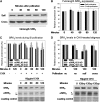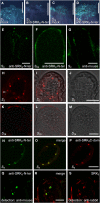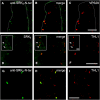Endocytosis and endosomal regulation of the S-receptor kinase during the self-incompatibility response in Brassica oleracea
- PMID: 19622804
- PMCID: PMC2729615
- DOI: 10.1105/tpc.108.063479
Endocytosis and endosomal regulation of the S-receptor kinase during the self-incompatibility response in Brassica oleracea
Abstract
Intracellular trafficking of plant receptor kinases (PRKs) is a key step in regulation of cellular signaling. Our current knowledge in this field is based on systems that address signaling pathways affecting the whole cell. There are, however, signaling phenomena that add a further layer of complexity. In the Brassica self-incompatibility response, a single cell can adequately respond to two opposite stimuli: accepting cross-pollen and rejecting self-pollen simultaneously. To understand how PRK signaling can influence the coexistence of two seemingly exclusive states of the cell, we investigated the subcellular localization and internalization of the S-receptor kinase (SRK) involved in the self-incompatibility response of Brassica oleracea. Here, we describe the unusual subcellular distribution of SRK3, which localizes predominantly to intracellular compartments and to a much lesser extent to the plasma membrane. Using an anti-SRK antibody that fully substitutes for the natural ligand, we demonstrate that the interaction with the receptor takes place at the plasma membrane and is followed by SRK internalization in endosomes that are enriched in the SRK negative regulator Thioredoxin-h-like1.
Figures





Comment in
-
Brassica self-incompatibility: a glimpse below the surface.Plant Signal Behav. 2009 Oct;4(10):996-8. doi: 10.4161/psb.4.10.9714. Epub 2009 Oct 30. Plant Signal Behav. 2009. PMID: 19826214 Free PMC article.
References
-
- Baluska, F., Parker, J.S., and Barlow, P.W. (1992). Specific patterns of cortical and endoplasmic microtubules associated with cell growth and tissue differentiation in roots of maize (Zea mays L.). J. Cell Sci. 103 191–200.
-
- Cabrillac, D., Cock, J.M., Dumas, C., and Gaude, T. (2001). The S-locus receptor kinase is inhibited by thioredoxins and activated by pollen coat proteins. Nature 410 220–223. - PubMed
Publication types
MeSH terms
Substances
Associated data
- Actions
- Actions
LinkOut - more resources
Full Text Sources
Research Materials

